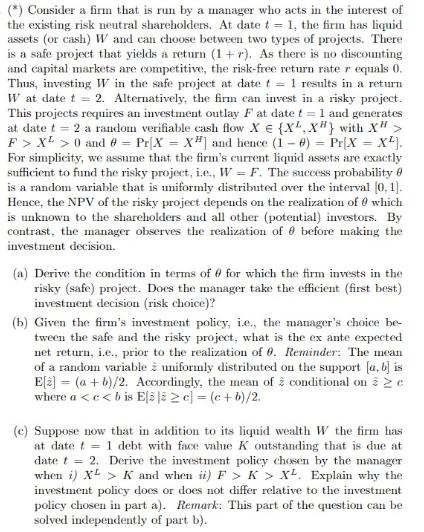Answered step by step
Verified Expert Solution
Question
1 Approved Answer
(*) Consider a firm that is run by a manager who acts in the interest of the existing risk neutral shareholders. At date t

(*) Consider a firm that is run by a manager who acts in the interest of the existing risk neutral shareholders. At date t = 1, the firm has liquid assets (or cash) W and can choose between two types of projects. There is a safe project that yields a return (1+r). As there is no discounting and capital markets are competitive, the risk-free return rate r equals 0. Thus, investing W in the safe project at date t = 1 results in a return W at date t = 2. Alternatively, the firm can invest in a risky project. This projects requires an investment outlay F at date t = 1 and generates at date t = 2 a random verifiable cash flow XE {XL, XH} with X > F> XL> 0 and = Pr[X = X"] and hence (1-0) - Pr[X = X]. For simplicity, we assume that the firm's current liquid assets are exactly sufficient to fund the risky project, i.e., W = F. The success probability is a random variable that is uniformly distributed over the interval [0, 1]. Hence, the NPV of the risky project depends on the realization of which is unknown to the shareholders and all other (potential) investors. By contrast, the manager observes the realization of before making the investment decision. (a) Derive the condition in terms of 0 for which the firm invests in the risky (safe) project. Does the manager take the efficient (first best) investment decision (risk choice)? (b) Given the firm's investment policy, i.e., the manager's choice be- tween the safe and the risky project, what is the ex ante expected net return, i.e., prior to the realization of 0. Reminder: The mean of a random variable uniformly distributed on the support [a, b] is E[2] = (a + b)/2. Accordingly, the mean of 2 conditional on 2 c where a K> X. Explain why the investment policy does or does not differ relative to the investment policy chosen in part a). Remark: This part of the question can be solved independently of part b).
Step by Step Solution
★★★★★
3.38 Rating (145 Votes )
There are 3 Steps involved in it
Step: 1
a To determine the condition for the firm to invest in the risky project we compare the net present value NPV of the ...
Get Instant Access to Expert-Tailored Solutions
See step-by-step solutions with expert insights and AI powered tools for academic success
Step: 2

Step: 3

Ace Your Homework with AI
Get the answers you need in no time with our AI-driven, step-by-step assistance
Get Started


